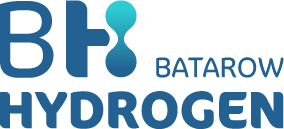Green hydrogen is produced by hydrogen electrolysis in an electrolyzer. Typically, an electrolyzer (electrolysis device) contains two electrodes that are brought into contact with an electrically conductive liquid (an electrolyte). An electrical voltage is applied between the electrodes so that an electric current flows. The electrical current directly determines the amount of material converted per second. The negative electrode is called the cathode, and the positive electrode is called the anode. New chemical substances can form at the electrodes, and it is also possible for electrode material to dissolve into the solution. To prevent this, electrodes can be made of certain precious metals (e.g., gold or platinum) or graphite.
The anode and cathode chambers are often separated by a porous wall (a diaphragm, e.g. made of resin, or a special membrane). This prevents the gases produced from mixing with each other, for example. However, such a membrane also hinders the flow of current to a greater or lesser extent and can thus reduce the power output and/or require a slightly higher electrical voltage, which reduces efficiency.
In water electrolysis for the production of hydrogen and oxygen, the conductivity of the water is increased by adding certain acids or bases (alkalis). (Alkaline water electrolysis according to the Claude process is widely used.) Hydrogen is produced at the cathode and oxygen at the anode, which must remain separate from the hydrogen and can also be used. To prevent oxidation of the anode, it must be made of a precious metal or nickel, for example.
Source: Dr. Rüdiger Paschotta. www.energie-lexikon.info. [Online] [Zitat vom 28.10.2021]
https://www.energie-lexikon.info/elektrolyse.html


